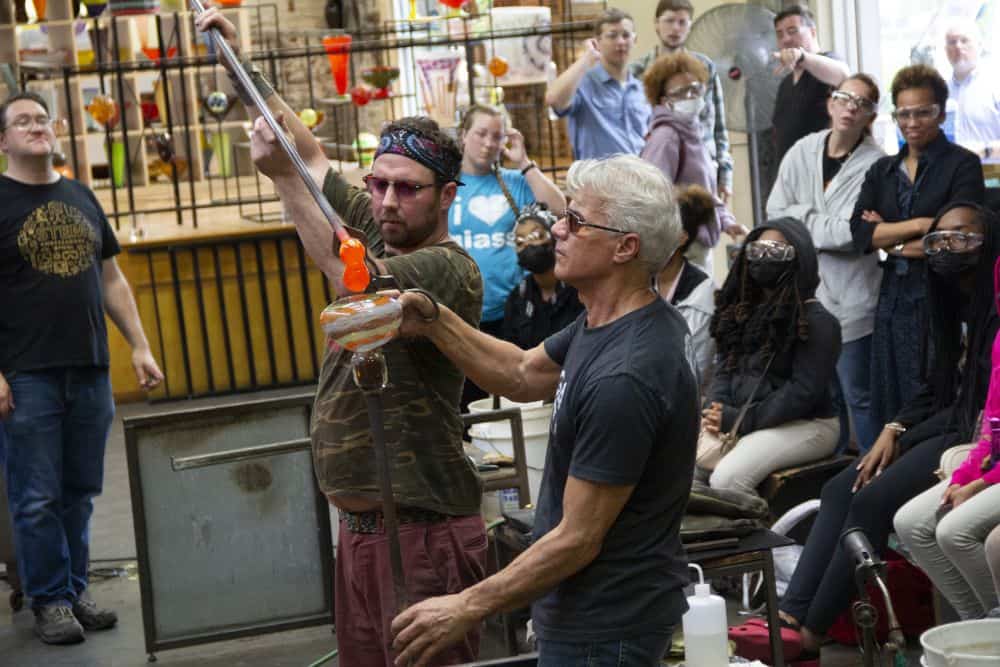
[Image above] Anthony Corradetti (center) works with an apprentice glassworker to demonstrate glassworking principles to Baltimore public high school students as part of GOMD’s International Year of Glass outreach. Credit: ACerS
ACerS Glass & Optical Materials Division held its 2022 annual meeting and conference in Baltimore, Md., May 22–26, 2022.
GOMD was among the first of ACerS Division meetings to be cancelled in 2020 due to the COVID-19 pandemic, and the community made the most of being together in person again. Friends and colleagues greeted each other warmly at a reception Sunday evening, undeterred by a fierce summertime thunderstorm on display through the glass-roofed atrium of the Hyatt Regency Baltimore Inner Harbor.
The conference, which is always excellent, gained added luster from the United Nations declaring 2022 the International Year of Glass (IYOG). About 215 people attended the conference in person, and 59 provided prerecorded presentations. Student participation was strong with 53 in attendance, and 22 countries were represented.
Program coorganizer Charmayne Lonergan says, “People seemed to enjoy the program and are excited to be back in person. It’s like the coming together of family members. Even though the science has evolved, it feels like coming home, regardless of the city.”
The pandemic definitely took its toll over the last two years. Lonergan noted, “Some graduate students are attending their first conference, … and they are just about ready to defend!” Unfortunately, COVID-19 provided a reminder that it is far from over when conference coorganizer Ashutosh Goel had to quarantine at home during the conference week.

Monday opened with the Stookey Lecture Award delivered by Herbert Gleiter. Gleiter, a world-renowned solid-state physicist, drew parallels between crystalline materials and nanoglasses after noting that “the world has a strong preference for crystalline materials.” A single crystal grown from the melt “takes the atoms it wants, and it is the same with nanoglasses,” he says. Likewise, “The nanoglass takes the atoms it wants.” Most of his examples were metallic glasses, but he showed other materials too, and he made a compelling case for a new way of thinking about amorphous materials from the nanostructure to new applications.

A poster session and reception on Monday evening drew attendees together to discuss science with students and other presenters. Chatter from conversations that began during the poster displays continued long after the session “ended,” providing more evidence of the importance of face-to-face interactions to the science communication process.
On Tuesday morning, John Ballato of Clemson University presented the George W. Morey Award lecture. He talked about new ways of thinking about optical fibers and some exciting new discoveries in the realm of photonic fibers. Ballato and his team have advanced the method of using molten cores to draw optical fibers. Initially, the goal was to defeat the optical limitations of core-clad optical fibers pulled from chemical vapor deposition preforms. The molten core method allowed the introduction of other oxides, such as alumina and barium oxide. Now, the research has taken them in the direction of using the molten core method to design and fabricate functional optical fibers, including fibers with crystalline cores.

The Darshana and Arun Varshneya Lectures in Glass Science and Glass Technology were presented, respectively, by Kathleen Richardson of the University of Central Florida and Qiang Fu of Corning Inc. on Wednesday and Thursday mornings.
Richardson’s talk on chalcogenide glasses linked market drivers and applications to glass science research and came full circle to development of products. Many applications based on germanium are in search of a new functional material because the cost of germanium is rising fast, and 90% of germanium comes from foreign sources.
Fu focused on three “stories” that he felt demonstrated the impact of glass on society: the discovery of bioactive glass by Larry Hench in 1969, the serendipitous discovery of glass-ceramics by Donald Stookey in 1954, and the creation of a glass sculpture of an evening gown. The common thread was humankind’s interaction with glass on many levels—materially and spiritually.
The banquet on Tuesday evening gave the community an opportunity to recognize its luminaries and rising stars. William LaCourse, professor of glass science at Alfred University, was honored with the L. David Pye Lifetime Achievement Award, and students were recognized for their poster presentations.
Inspired by the fact this year is IYOG, organizers invited two after-dinner speakers from outside the glass science realm. Kathy Jordan, president of the American Glass Guild and glass painter, presented examples of her work restoring damaged or destroyed stained glass windows. Peter Swanson, a documentary producer and director, talked about his documentary on the life and work of Rowan LeCompte, who designed 45 of the stained-glass windows installed at the National Cathedral in Washington, D.C. Swanson showed snippets of his documentary titled “Let there be light,” and he brought an interactive cabinet showcasing Rowan’s work to the conference for attendees to view during breaks.

An extracurricular field trip on Wednesday evening to Coppin State University in Baltimore gave attendees the opportunity to view the glass art exhibit, Fired Up!, featuring glass artworks. Though small, the exhibit covered a wide range of artforms, and the presence of artists provided an excellent point of intersection.
Although the conference ended on Thursday, GOMD organizers arranged an IYOG-themed outreach event with local schools on Friday that took place at a local glass blowing studio. Students from three local high schools participated and learned about glass compositions and properties in the context of watching artisan Anthony Corradetti create beautiful glass objects.
GOMD will hold its next annual meeting and conference June 4–9, 2023, in the Crescent City—New Orleans, La. It promises to be an excellent program and a great place to renew friendships, advance glass science, and keep the spirit of IYOG alive.
Be sure to check out ACerS Flickr album for images from the Baltimore conference.
